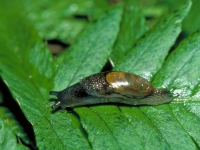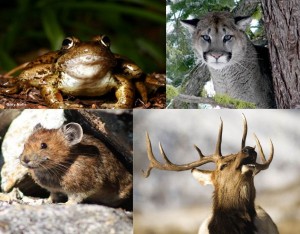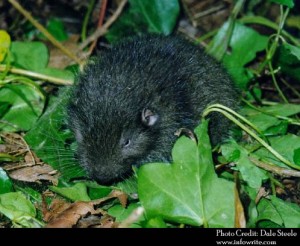From small to large – the following wildlife species are all present in the Cascades and specifically were analyzed during the development of the I-90 Snoqualmie Pass East Project as expected to utilize the Lake Keechelus Wildlife Overpass. They may walk, hop, or inch their way safely over I-90 on this new crossing structure – some taking longer then others.
Species are listed in alphabetical order by common name (latin name in italics in paranthesis), click on the name to learn more about the species and view photographs to inspire your animation. Efforts were made to find the most relevant links with information on the species, but for some rare species you may be directed to another state or region’s information on the species. We hope this provides a starting point to your own research on these mollusks, amphibians, reptiles, birds, and mammals.
- Amber glass snail (Nesovitrea electrina)
- American marten (Martes americana)
- Beaded lancetooth (Ancotrema sportella)
- Black bear (Ursus americanus)
- Bobcat (Lynx rufus)
- Brown hive snail (Euconulus fulvus)
- Brown slug (Deroceras laeve)
- Bushy tailed woodrat (Neotoma cinerea)
- Cascade red fox (Vulpes vulpes cascadensis)
- Cascades frog (Rana cascadae)
- Columbia vertigo (Vertigo columbiana)
- Common garter snake (Thamnophis sirtalis)
- Conical spot (Punctum randolphii)
-

The Dromedary jumping slug carries their internal organs in a hump on their back, and when a predator moves in to attack them they perform their signature move they earned their name for – flipping and turning their bodies. Credit: The Nature Conservancy
Cougar, also known as mountain lion (Puma concolor)
- Coyote (Canis latrans)
- Creeping vole (Microtus oregoni)
- Cross vertigo (Vertigo modesta, click here for species information)
- Deer mouse (Peromyscus maniculatus)
- Douglas squirrel (Tamiasciurus douglasii)
- Dromedary jumping slug (Hemphillia dromedarius)
- Gapper’s red-backed mouse, also known as southern red-backed vole (Myodes gapperi)
- Garlic glass-snail (Oxychilus alliarius)
- Grizzly bear (Ursus arctos horribilis)
- Gray wolf (Canis lupus)
- Heather vole (Phenacomys intermedius, click here for species information)
- Hoary marmot (Marmota caligata)
- Land snail (Haplotema vancourverense, click here for species information)
- Long-tailed weasel (Mustela frenata)
- Masked shrew, also known as the Cineras shrew (Sorex cinereus)
- Montane vole (Microtus montanus)
- Mountain beaver, also known as Sewellel (Aplodontia rufa)
- Mountain goat (Oreamnos americanus)
- Mule deer (Odocoileus hemionus)
- Northern alligator lizard (Elgaria coerulea)
- Northern flying squirrel (Glaucomys sabrinus)
- Northern pocket gopher (Thomomys talpoides)
- Northern tightcoil (Pristiloma articum)
- Northwest hesperian (Vespericola columbianus)
- Northwest striate (Striatura pugetensis)
- Pacific Giant Salamander (Dicamptodon tenebrosus)
- Pacific jumping mouse (Zapus trinotatus)
- Pacific tree frog (Pseudacris regilla)
- Pacific water shrew, also known as the marsh shrew (Sorex bendirii)
- Papillise taildropper (Prophysaon dubium, click here for species information)
- Porcupine (Erethizon dorsatum)
- Rocky Mountain elk (Cervus elaphus nelsoni)
- Rubber boa (Charina bottae)
- Ruffed grouse (Bonasa umbellus)
- Scarletback taildropper (Prophysaon vanattae)
- Short-tailed weasel, also known as ermine (Mustela erminea)
- Shrew mole (Neurotrichus gibbsii)
- Snowshoe hare (Lepus americanus)
- Sooty grouse (Dendragapus fuliginosus)
- Toothless column snail (Columella endentula)
- Townsend’s chipmunk (Tamias townsendii)
- Vagrant shrew (Sorex vagrans)
- Water shrew (Sorex palustris)
- Water vole (Microtus richardsoni)
- Western terrestrial garter snake (Thamnophis elegans)
- Western toad (Bufo boreas)
- Wolverine (Gulo gulo)
Our Bridging Futures 2015 contest co-hosted with the Washington Department of Transportation asked students to help us animate these amazing animals.
** This page does not represent every species that is present in the I-90 corridor and that may utilize the wildlife overpass, but aims to represent as many species as possible where photographs and species information were readily available.


